Auditing and Assurance Report: Cloud 9 and Executive Pay Study
VerifiedAdded on 2023/04/20
|12
|2348
|466
Report
AI Summary
This report provides a detailed analysis of auditing and assurance principles, focusing on the financial performance of Cloud 9. It begins by defining and calculating planning materiality, crucial for determining the impact of misstatements. The report then delves into analytical procedures, using ratio analysis to assess Cloud 9's profitability, liquidity, and solvency. The profitability section examines EBIT and net profit margins, while the liquidity analysis assesses current and quick ratios. Solvency is evaluated through debt-to-equity and debt-to-total-assets ratios. Additionally, the report includes a case study on executive compensation in the mining industry, examining the remuneration of executives at BHP Billiton, Rio Tinto, and Newcrest Mining, linking pay to company performance, and drawing overall conclusions about Australian executive remuneration practices. The report uses the annual reports of the mining companies to assess the remuneration pattern of the key executives. The report provides insights into financial reporting, auditing practices, and corporate governance.
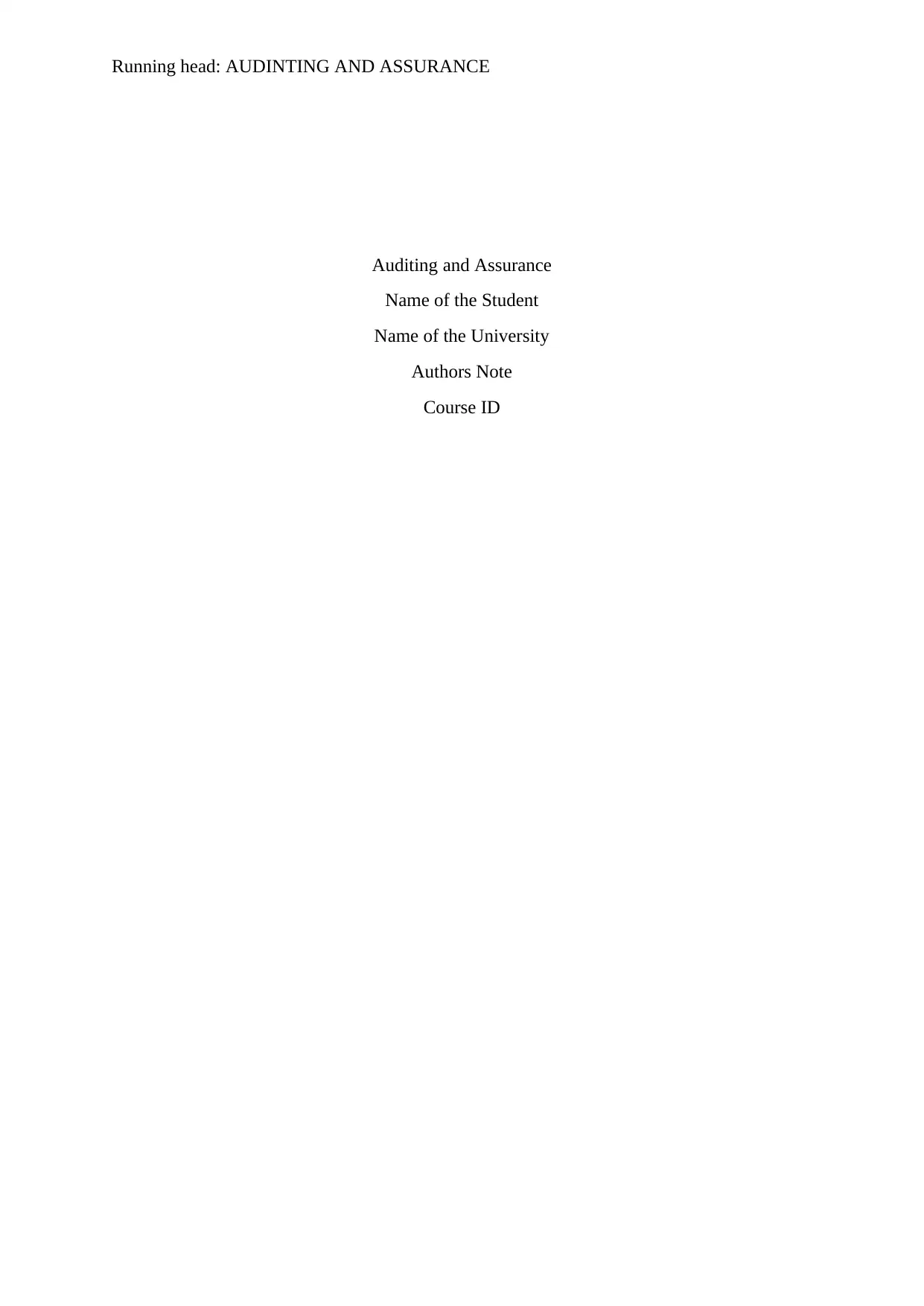
Running head: AUDINTING AND ASSURANCE
Auditing and Assurance
Name of the Student
Name of the University
Authors Note
Course ID
Auditing and Assurance
Name of the Student
Name of the University
Authors Note
Course ID
Paraphrase This Document
Need a fresh take? Get an instant paraphrase of this document with our AI Paraphraser
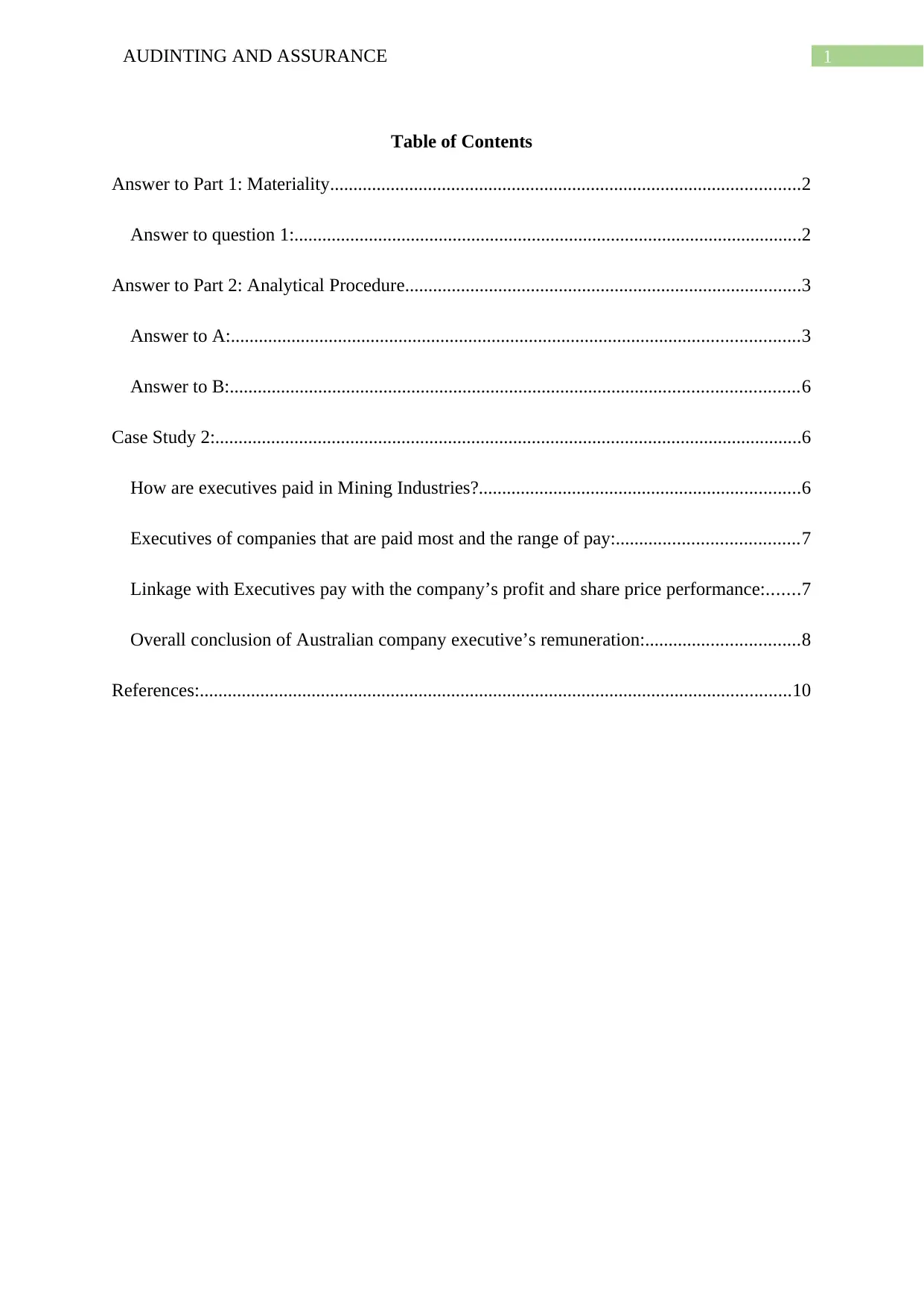
1AUDINTING AND ASSURANCE
Table of Contents
Answer to Part 1: Materiality.....................................................................................................2
Answer to question 1:.............................................................................................................2
Answer to Part 2: Analytical Procedure.....................................................................................3
Answer to A:..........................................................................................................................3
Answer to B:..........................................................................................................................6
Case Study 2:..............................................................................................................................6
How are executives paid in Mining Industries?.....................................................................6
Executives of companies that are paid most and the range of pay:.......................................7
Linkage with Executives pay with the company’s profit and share price performance:.......7
Overall conclusion of Australian company executive’s remuneration:.................................8
References:...............................................................................................................................10
Table of Contents
Answer to Part 1: Materiality.....................................................................................................2
Answer to question 1:.............................................................................................................2
Answer to Part 2: Analytical Procedure.....................................................................................3
Answer to A:..........................................................................................................................3
Answer to B:..........................................................................................................................6
Case Study 2:..............................................................................................................................6
How are executives paid in Mining Industries?.....................................................................6
Executives of companies that are paid most and the range of pay:.......................................7
Linkage with Executives pay with the company’s profit and share price performance:.......7
Overall conclusion of Australian company executive’s remuneration:.................................8
References:...............................................................................................................................10
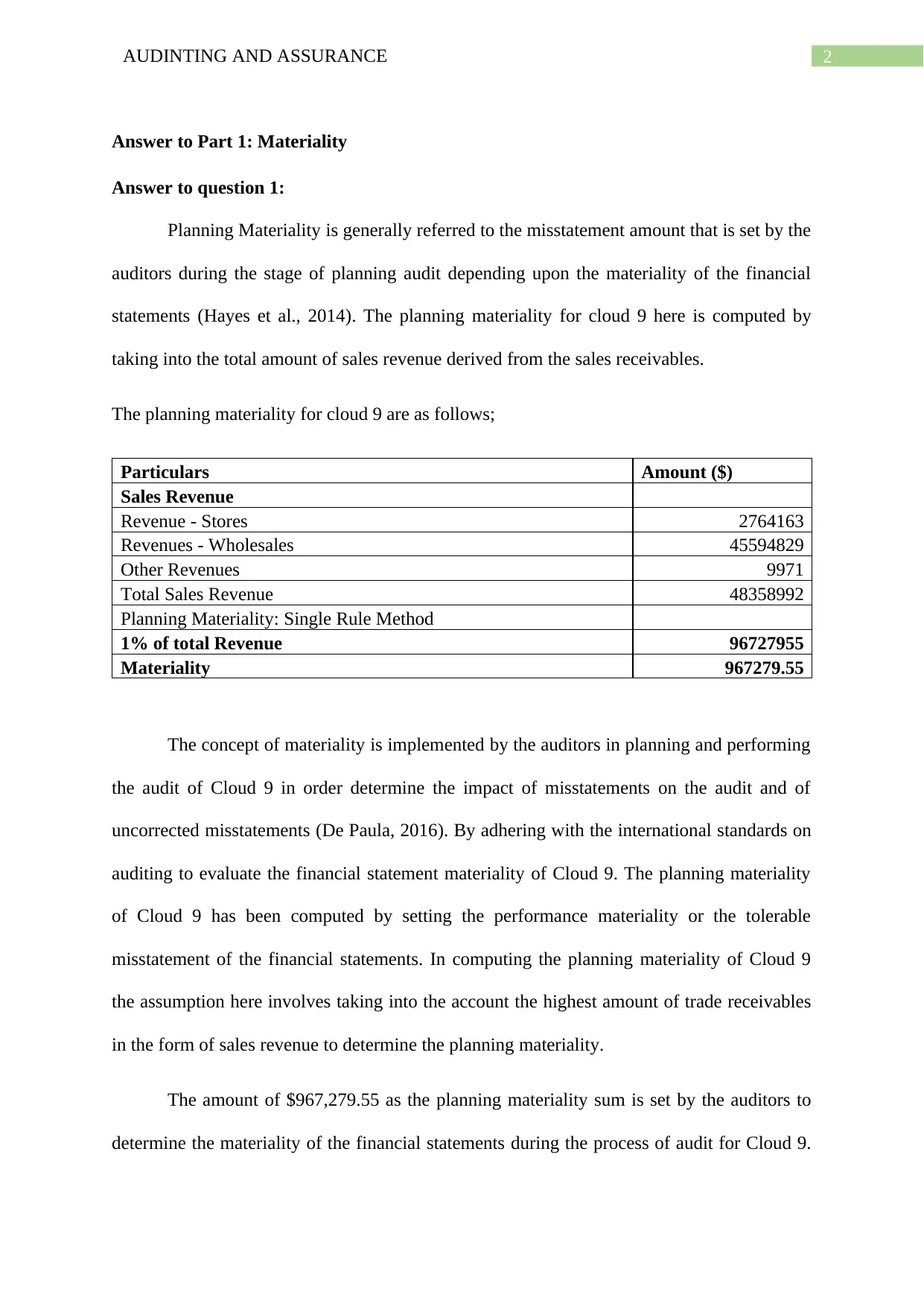
2AUDINTING AND ASSURANCE
Answer to Part 1: Materiality
Answer to question 1:
Planning Materiality is generally referred to the misstatement amount that is set by the
auditors during the stage of planning audit depending upon the materiality of the financial
statements (Hayes et al., 2014). The planning materiality for cloud 9 here is computed by
taking into the total amount of sales revenue derived from the sales receivables.
The planning materiality for cloud 9 are as follows;
Particulars Amount ($)
Sales Revenue
Revenue - Stores 2764163
Revenues - Wholesales 45594829
Other Revenues 9971
Total Sales Revenue 48358992
Planning Materiality: Single Rule Method
1% of total Revenue 96727955
Materiality 967279.55
The concept of materiality is implemented by the auditors in planning and performing
the audit of Cloud 9 in order determine the impact of misstatements on the audit and of
uncorrected misstatements (De Paula, 2016). By adhering with the international standards on
auditing to evaluate the financial statement materiality of Cloud 9. The planning materiality
of Cloud 9 has been computed by setting the performance materiality or the tolerable
misstatement of the financial statements. In computing the planning materiality of Cloud 9
the assumption here involves taking into the account the highest amount of trade receivables
in the form of sales revenue to determine the planning materiality.
The amount of $967,279.55 as the planning materiality sum is set by the auditors to
determine the materiality of the financial statements during the process of audit for Cloud 9.
Answer to Part 1: Materiality
Answer to question 1:
Planning Materiality is generally referred to the misstatement amount that is set by the
auditors during the stage of planning audit depending upon the materiality of the financial
statements (Hayes et al., 2014). The planning materiality for cloud 9 here is computed by
taking into the total amount of sales revenue derived from the sales receivables.
The planning materiality for cloud 9 are as follows;
Particulars Amount ($)
Sales Revenue
Revenue - Stores 2764163
Revenues - Wholesales 45594829
Other Revenues 9971
Total Sales Revenue 48358992
Planning Materiality: Single Rule Method
1% of total Revenue 96727955
Materiality 967279.55
The concept of materiality is implemented by the auditors in planning and performing
the audit of Cloud 9 in order determine the impact of misstatements on the audit and of
uncorrected misstatements (De Paula, 2016). By adhering with the international standards on
auditing to evaluate the financial statement materiality of Cloud 9. The planning materiality
of Cloud 9 has been computed by setting the performance materiality or the tolerable
misstatement of the financial statements. In computing the planning materiality of Cloud 9
the assumption here involves taking into the account the highest amount of trade receivables
in the form of sales revenue to determine the planning materiality.
The amount of $967,279.55 as the planning materiality sum is set by the auditors to
determine the materiality of the financial statements during the process of audit for Cloud 9.
⊘ This is a preview!⊘
Do you want full access?
Subscribe today to unlock all pages.

Trusted by 1+ million students worldwide
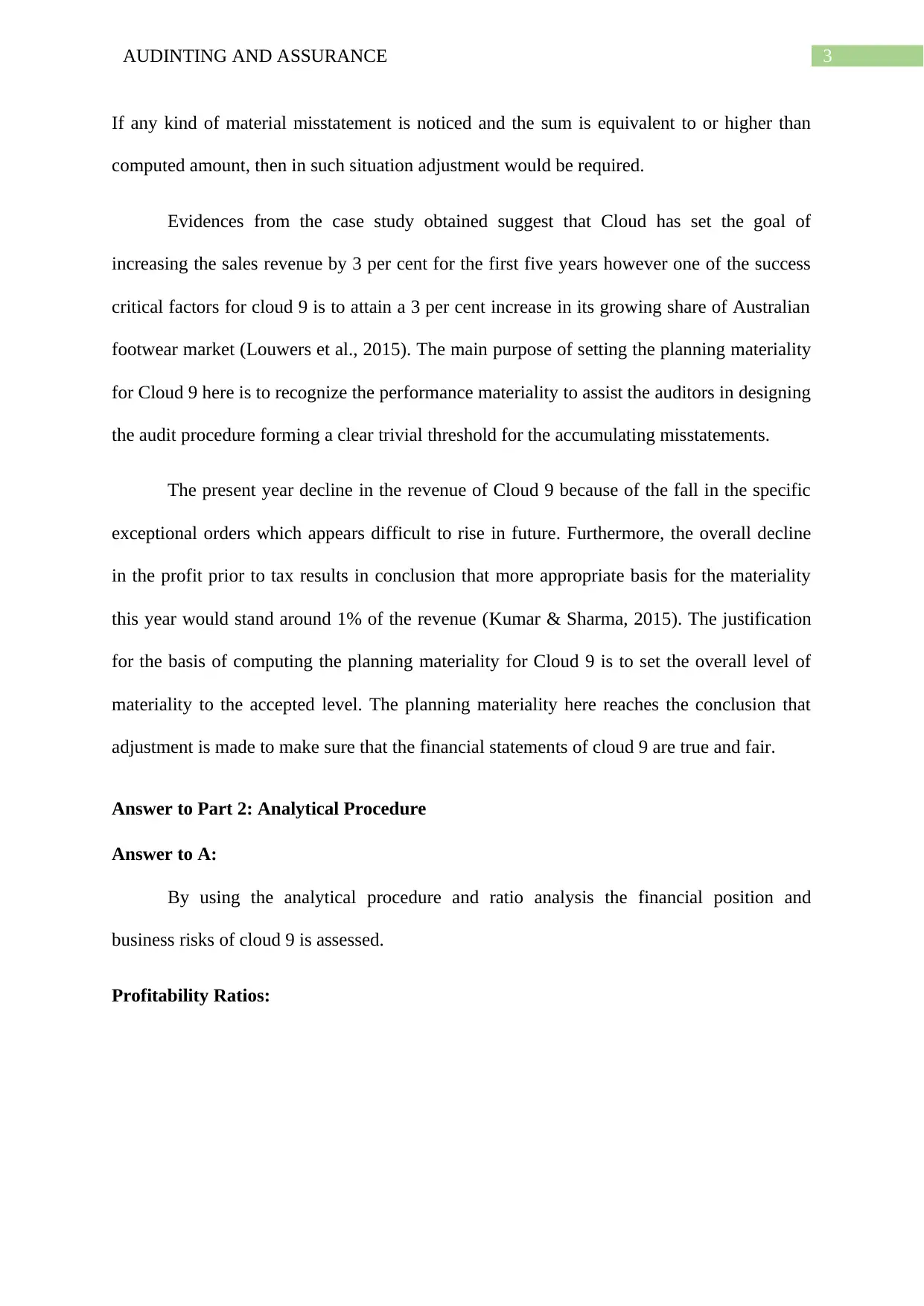
3AUDINTING AND ASSURANCE
If any kind of material misstatement is noticed and the sum is equivalent to or higher than
computed amount, then in such situation adjustment would be required.
Evidences from the case study obtained suggest that Cloud has set the goal of
increasing the sales revenue by 3 per cent for the first five years however one of the success
critical factors for cloud 9 is to attain a 3 per cent increase in its growing share of Australian
footwear market (Louwers et al., 2015). The main purpose of setting the planning materiality
for Cloud 9 here is to recognize the performance materiality to assist the auditors in designing
the audit procedure forming a clear trivial threshold for the accumulating misstatements.
The present year decline in the revenue of Cloud 9 because of the fall in the specific
exceptional orders which appears difficult to rise in future. Furthermore, the overall decline
in the profit prior to tax results in conclusion that more appropriate basis for the materiality
this year would stand around 1% of the revenue (Kumar & Sharma, 2015). The justification
for the basis of computing the planning materiality for Cloud 9 is to set the overall level of
materiality to the accepted level. The planning materiality here reaches the conclusion that
adjustment is made to make sure that the financial statements of cloud 9 are true and fair.
Answer to Part 2: Analytical Procedure
Answer to A:
By using the analytical procedure and ratio analysis the financial position and
business risks of cloud 9 is assessed.
Profitability Ratios:
If any kind of material misstatement is noticed and the sum is equivalent to or higher than
computed amount, then in such situation adjustment would be required.
Evidences from the case study obtained suggest that Cloud has set the goal of
increasing the sales revenue by 3 per cent for the first five years however one of the success
critical factors for cloud 9 is to attain a 3 per cent increase in its growing share of Australian
footwear market (Louwers et al., 2015). The main purpose of setting the planning materiality
for Cloud 9 here is to recognize the performance materiality to assist the auditors in designing
the audit procedure forming a clear trivial threshold for the accumulating misstatements.
The present year decline in the revenue of Cloud 9 because of the fall in the specific
exceptional orders which appears difficult to rise in future. Furthermore, the overall decline
in the profit prior to tax results in conclusion that more appropriate basis for the materiality
this year would stand around 1% of the revenue (Kumar & Sharma, 2015). The justification
for the basis of computing the planning materiality for Cloud 9 is to set the overall level of
materiality to the accepted level. The planning materiality here reaches the conclusion that
adjustment is made to make sure that the financial statements of cloud 9 are true and fair.
Answer to Part 2: Analytical Procedure
Answer to A:
By using the analytical procedure and ratio analysis the financial position and
business risks of cloud 9 is assessed.
Profitability Ratios:
Paraphrase This Document
Need a fresh take? Get an instant paraphrase of this document with our AI Paraphraser
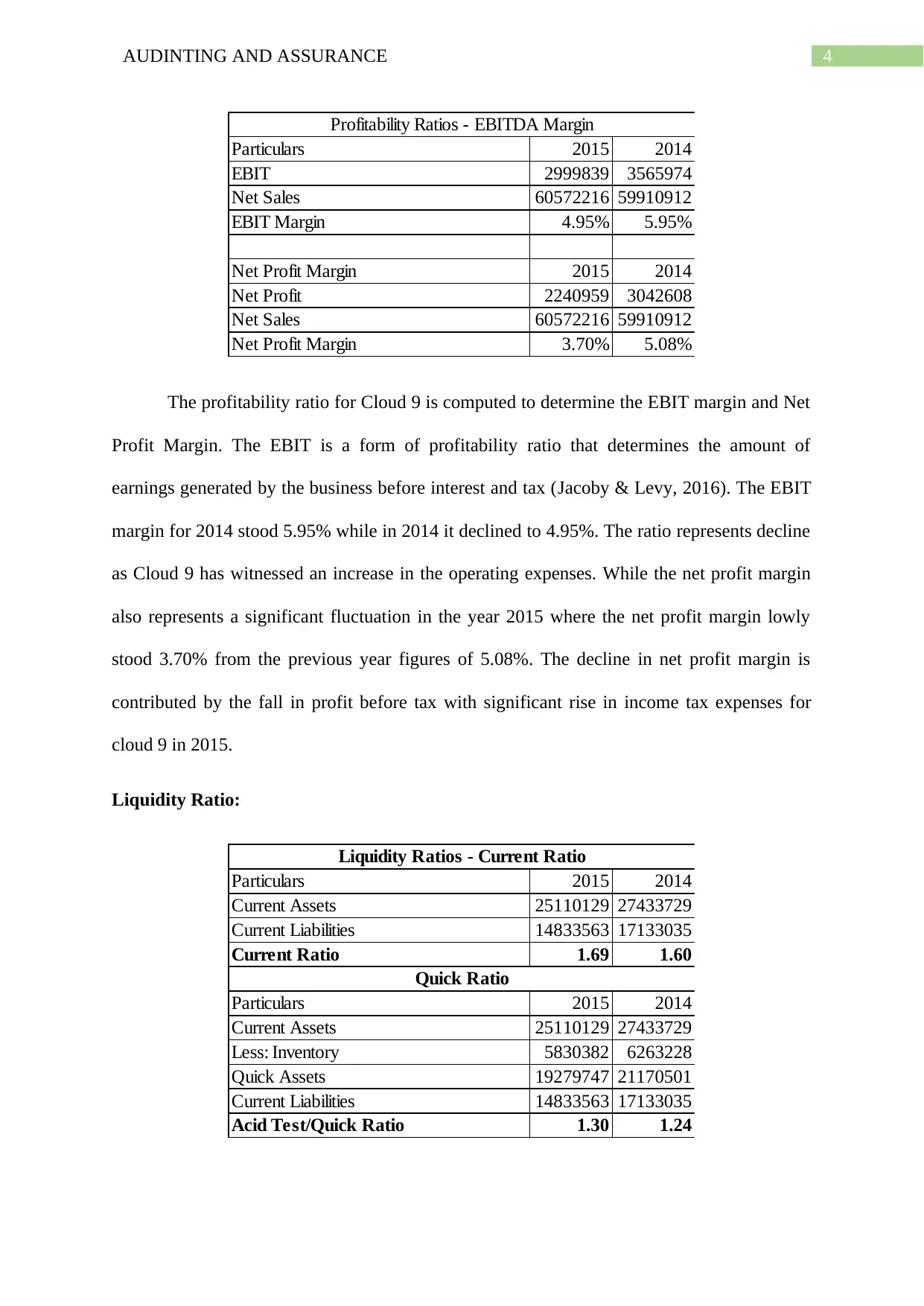
4AUDINTING AND ASSURANCE
Particulars 2015 2014
EBIT 2999839 3565974
Net Sales 60572216 59910912
EBIT Margin 4.95% 5.95%
Net Profit Margin 2015 2014
Net Profit 2240959 3042608
Net Sales 60572216 59910912
Net Profit Margin 3.70% 5.08%
Profitability Ratios - EBITDA Margin
The profitability ratio for Cloud 9 is computed to determine the EBIT margin and Net
Profit Margin. The EBIT is a form of profitability ratio that determines the amount of
earnings generated by the business before interest and tax (Jacoby & Levy, 2016). The EBIT
margin for 2014 stood 5.95% while in 2014 it declined to 4.95%. The ratio represents decline
as Cloud 9 has witnessed an increase in the operating expenses. While the net profit margin
also represents a significant fluctuation in the year 2015 where the net profit margin lowly
stood 3.70% from the previous year figures of 5.08%. The decline in net profit margin is
contributed by the fall in profit before tax with significant rise in income tax expenses for
cloud 9 in 2015.
Liquidity Ratio:
Particulars 2015 2014
Current Assets 25110129 27433729
Current Liabilities 14833563 17133035
Current Ratio 1.69 1.60
Particulars 2015 2014
Current Assets 25110129 27433729
Less: Inventory 5830382 6263228
Quick Assets 19279747 21170501
Current Liabilities 14833563 17133035
Acid Test/Quick Ratio 1.30 1.24
Liquidity Ratios - Current Ratio
Quick Ratio
Particulars 2015 2014
EBIT 2999839 3565974
Net Sales 60572216 59910912
EBIT Margin 4.95% 5.95%
Net Profit Margin 2015 2014
Net Profit 2240959 3042608
Net Sales 60572216 59910912
Net Profit Margin 3.70% 5.08%
Profitability Ratios - EBITDA Margin
The profitability ratio for Cloud 9 is computed to determine the EBIT margin and Net
Profit Margin. The EBIT is a form of profitability ratio that determines the amount of
earnings generated by the business before interest and tax (Jacoby & Levy, 2016). The EBIT
margin for 2014 stood 5.95% while in 2014 it declined to 4.95%. The ratio represents decline
as Cloud 9 has witnessed an increase in the operating expenses. While the net profit margin
also represents a significant fluctuation in the year 2015 where the net profit margin lowly
stood 3.70% from the previous year figures of 5.08%. The decline in net profit margin is
contributed by the fall in profit before tax with significant rise in income tax expenses for
cloud 9 in 2015.
Liquidity Ratio:
Particulars 2015 2014
Current Assets 25110129 27433729
Current Liabilities 14833563 17133035
Current Ratio 1.69 1.60
Particulars 2015 2014
Current Assets 25110129 27433729
Less: Inventory 5830382 6263228
Quick Assets 19279747 21170501
Current Liabilities 14833563 17133035
Acid Test/Quick Ratio 1.30 1.24
Liquidity Ratios - Current Ratio
Quick Ratio
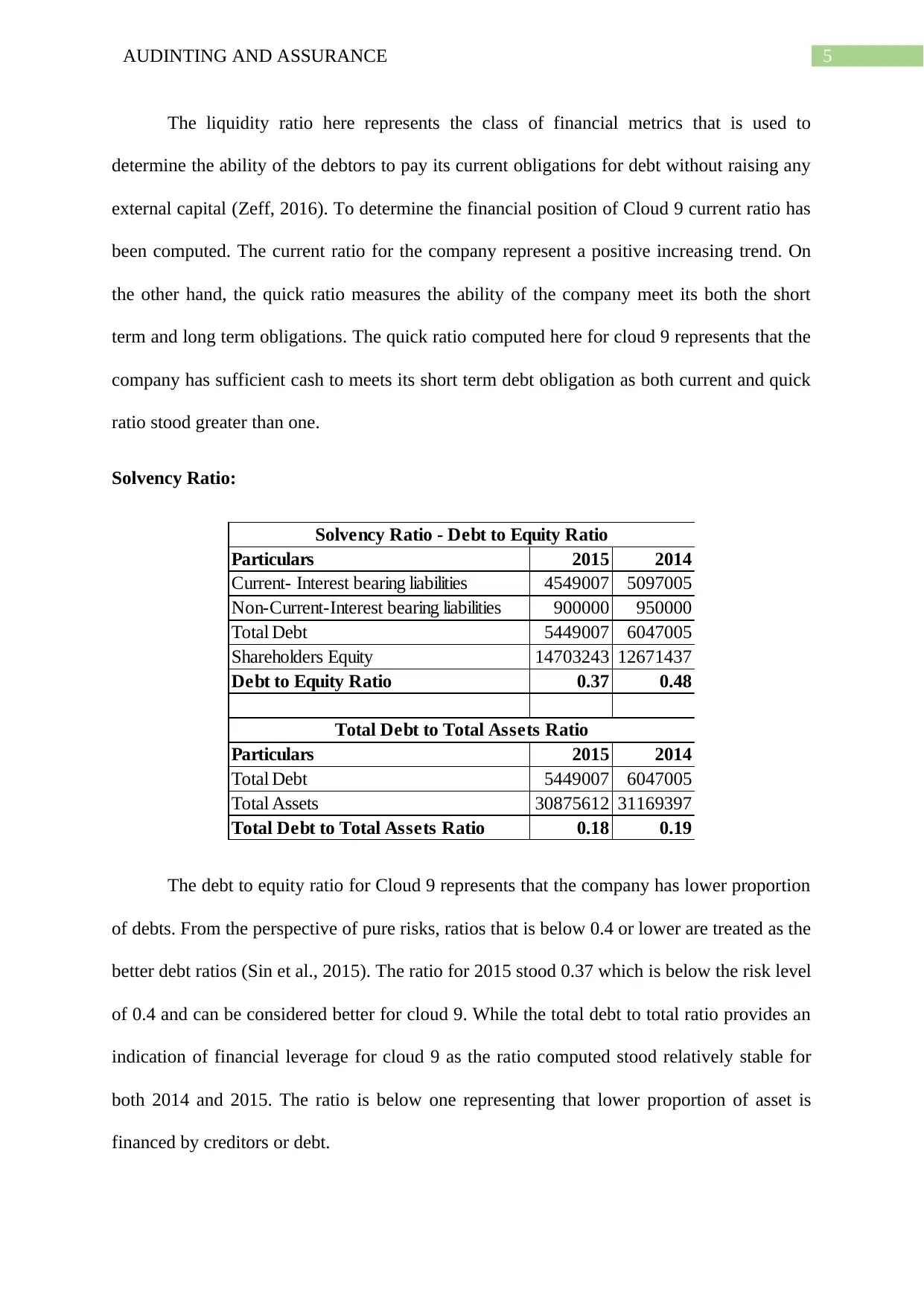
5AUDINTING AND ASSURANCE
The liquidity ratio here represents the class of financial metrics that is used to
determine the ability of the debtors to pay its current obligations for debt without raising any
external capital (Zeff, 2016). To determine the financial position of Cloud 9 current ratio has
been computed. The current ratio for the company represent a positive increasing trend. On
the other hand, the quick ratio measures the ability of the company meet its both the short
term and long term obligations. The quick ratio computed here for cloud 9 represents that the
company has sufficient cash to meets its short term debt obligation as both current and quick
ratio stood greater than one.
Solvency Ratio:
Particulars 2015 2014
Current- Interest bearing liabilities 4549007 5097005
Non-Current-Interest bearing liabilities 900000 950000
Total Debt 5449007 6047005
Shareholders Equity 14703243 12671437
Debt to Equity Ratio 0.37 0.48
Particulars 2015 2014
Total Debt 5449007 6047005
Total Assets 30875612 31169397
Total Debt to Total Assets Ratio 0.18 0.19
Solvency Ratio - Debt to Equity Ratio
Total Debt to Total Assets Ratio
The debt to equity ratio for Cloud 9 represents that the company has lower proportion
of debts. From the perspective of pure risks, ratios that is below 0.4 or lower are treated as the
better debt ratios (Sin et al., 2015). The ratio for 2015 stood 0.37 which is below the risk level
of 0.4 and can be considered better for cloud 9. While the total debt to total ratio provides an
indication of financial leverage for cloud 9 as the ratio computed stood relatively stable for
both 2014 and 2015. The ratio is below one representing that lower proportion of asset is
financed by creditors or debt.
The liquidity ratio here represents the class of financial metrics that is used to
determine the ability of the debtors to pay its current obligations for debt without raising any
external capital (Zeff, 2016). To determine the financial position of Cloud 9 current ratio has
been computed. The current ratio for the company represent a positive increasing trend. On
the other hand, the quick ratio measures the ability of the company meet its both the short
term and long term obligations. The quick ratio computed here for cloud 9 represents that the
company has sufficient cash to meets its short term debt obligation as both current and quick
ratio stood greater than one.
Solvency Ratio:
Particulars 2015 2014
Current- Interest bearing liabilities 4549007 5097005
Non-Current-Interest bearing liabilities 900000 950000
Total Debt 5449007 6047005
Shareholders Equity 14703243 12671437
Debt to Equity Ratio 0.37 0.48
Particulars 2015 2014
Total Debt 5449007 6047005
Total Assets 30875612 31169397
Total Debt to Total Assets Ratio 0.18 0.19
Solvency Ratio - Debt to Equity Ratio
Total Debt to Total Assets Ratio
The debt to equity ratio for Cloud 9 represents that the company has lower proportion
of debts. From the perspective of pure risks, ratios that is below 0.4 or lower are treated as the
better debt ratios (Sin et al., 2015). The ratio for 2015 stood 0.37 which is below the risk level
of 0.4 and can be considered better for cloud 9. While the total debt to total ratio provides an
indication of financial leverage for cloud 9 as the ratio computed stood relatively stable for
both 2014 and 2015. The ratio is below one representing that lower proportion of asset is
financed by creditors or debt.
⊘ This is a preview!⊘
Do you want full access?
Subscribe today to unlock all pages.

Trusted by 1+ million students worldwide
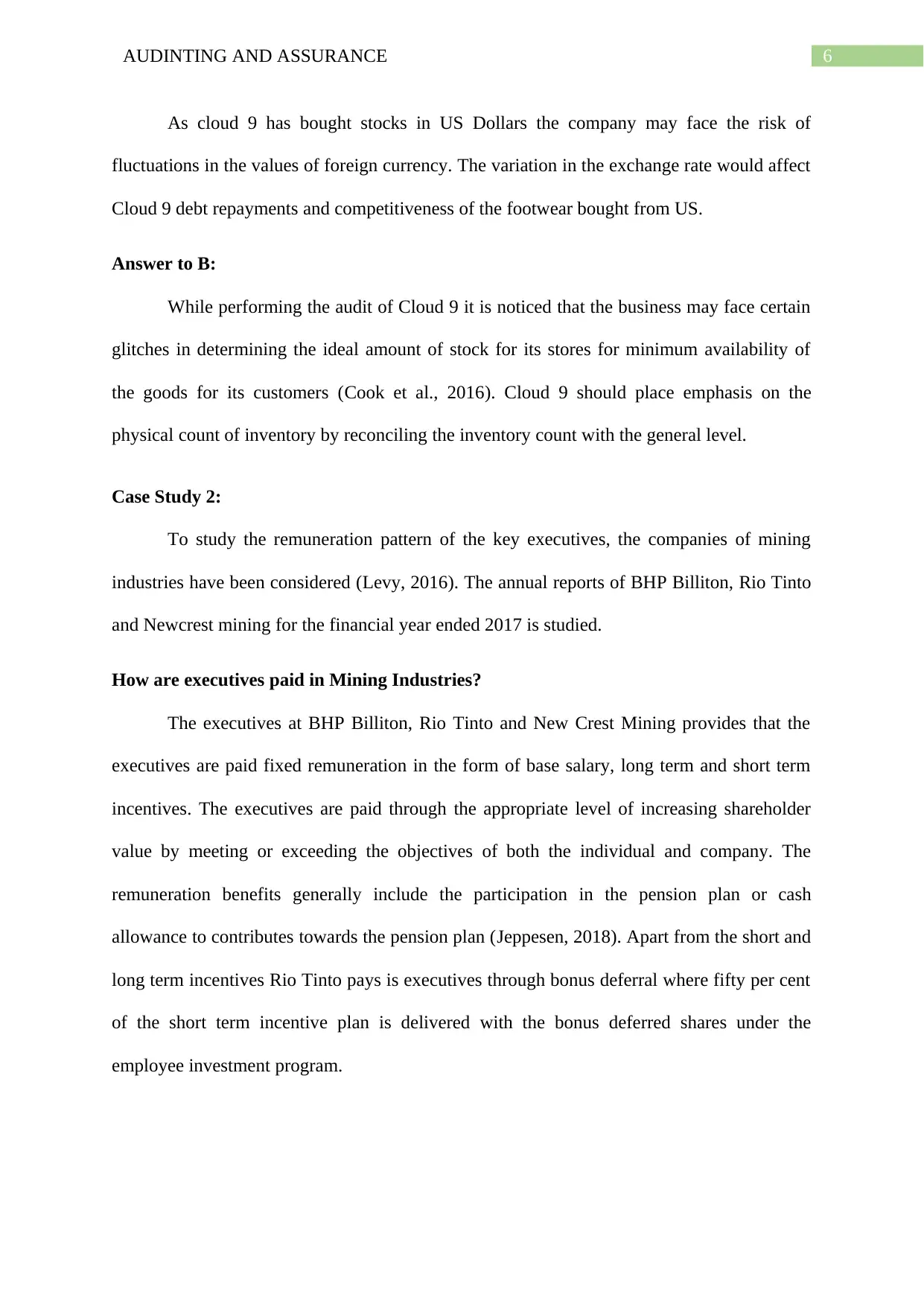
6AUDINTING AND ASSURANCE
As cloud 9 has bought stocks in US Dollars the company may face the risk of
fluctuations in the values of foreign currency. The variation in the exchange rate would affect
Cloud 9 debt repayments and competitiveness of the footwear bought from US.
Answer to B:
While performing the audit of Cloud 9 it is noticed that the business may face certain
glitches in determining the ideal amount of stock for its stores for minimum availability of
the goods for its customers (Cook et al., 2016). Cloud 9 should place emphasis on the
physical count of inventory by reconciling the inventory count with the general level.
Case Study 2:
To study the remuneration pattern of the key executives, the companies of mining
industries have been considered (Levy, 2016). The annual reports of BHP Billiton, Rio Tinto
and Newcrest mining for the financial year ended 2017 is studied.
How are executives paid in Mining Industries?
The executives at BHP Billiton, Rio Tinto and New Crest Mining provides that the
executives are paid fixed remuneration in the form of base salary, long term and short term
incentives. The executives are paid through the appropriate level of increasing shareholder
value by meeting or exceeding the objectives of both the individual and company. The
remuneration benefits generally include the participation in the pension plan or cash
allowance to contributes towards the pension plan (Jeppesen, 2018). Apart from the short and
long term incentives Rio Tinto pays is executives through bonus deferral where fifty per cent
of the short term incentive plan is delivered with the bonus deferred shares under the
employee investment program.
As cloud 9 has bought stocks in US Dollars the company may face the risk of
fluctuations in the values of foreign currency. The variation in the exchange rate would affect
Cloud 9 debt repayments and competitiveness of the footwear bought from US.
Answer to B:
While performing the audit of Cloud 9 it is noticed that the business may face certain
glitches in determining the ideal amount of stock for its stores for minimum availability of
the goods for its customers (Cook et al., 2016). Cloud 9 should place emphasis on the
physical count of inventory by reconciling the inventory count with the general level.
Case Study 2:
To study the remuneration pattern of the key executives, the companies of mining
industries have been considered (Levy, 2016). The annual reports of BHP Billiton, Rio Tinto
and Newcrest mining for the financial year ended 2017 is studied.
How are executives paid in Mining Industries?
The executives at BHP Billiton, Rio Tinto and New Crest Mining provides that the
executives are paid fixed remuneration in the form of base salary, long term and short term
incentives. The executives are paid through the appropriate level of increasing shareholder
value by meeting or exceeding the objectives of both the individual and company. The
remuneration benefits generally include the participation in the pension plan or cash
allowance to contributes towards the pension plan (Jeppesen, 2018). Apart from the short and
long term incentives Rio Tinto pays is executives through bonus deferral where fifty per cent
of the short term incentive plan is delivered with the bonus deferred shares under the
employee investment program.
Paraphrase This Document
Need a fresh take? Get an instant paraphrase of this document with our AI Paraphraser
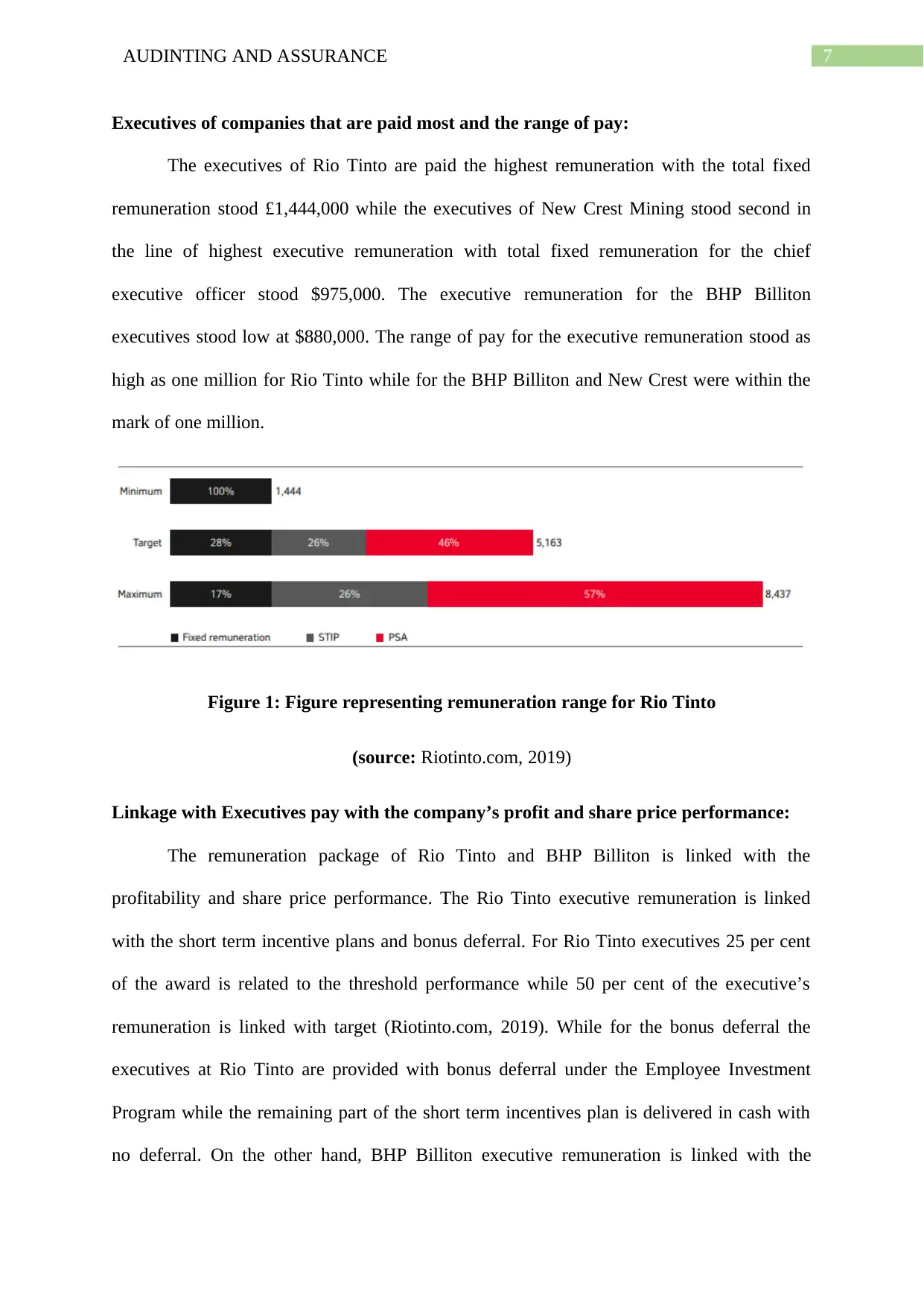
7AUDINTING AND ASSURANCE
Executives of companies that are paid most and the range of pay:
The executives of Rio Tinto are paid the highest remuneration with the total fixed
remuneration stood £1,444,000 while the executives of New Crest Mining stood second in
the line of highest executive remuneration with total fixed remuneration for the chief
executive officer stood $975,000. The executive remuneration for the BHP Billiton
executives stood low at $880,000. The range of pay for the executive remuneration stood as
high as one million for Rio Tinto while for the BHP Billiton and New Crest were within the
mark of one million.
Figure 1: Figure representing remuneration range for Rio Tinto
(source: Riotinto.com, 2019)
Linkage with Executives pay with the company’s profit and share price performance:
The remuneration package of Rio Tinto and BHP Billiton is linked with the
profitability and share price performance. The Rio Tinto executive remuneration is linked
with the short term incentive plans and bonus deferral. For Rio Tinto executives 25 per cent
of the award is related to the threshold performance while 50 per cent of the executive’s
remuneration is linked with target (Riotinto.com, 2019). While for the bonus deferral the
executives at Rio Tinto are provided with bonus deferral under the Employee Investment
Program while the remaining part of the short term incentives plan is delivered in cash with
no deferral. On the other hand, BHP Billiton executive remuneration is linked with the
Executives of companies that are paid most and the range of pay:
The executives of Rio Tinto are paid the highest remuneration with the total fixed
remuneration stood £1,444,000 while the executives of New Crest Mining stood second in
the line of highest executive remuneration with total fixed remuneration for the chief
executive officer stood $975,000. The executive remuneration for the BHP Billiton
executives stood low at $880,000. The range of pay for the executive remuneration stood as
high as one million for Rio Tinto while for the BHP Billiton and New Crest were within the
mark of one million.
Figure 1: Figure representing remuneration range for Rio Tinto
(source: Riotinto.com, 2019)
Linkage with Executives pay with the company’s profit and share price performance:
The remuneration package of Rio Tinto and BHP Billiton is linked with the
profitability and share price performance. The Rio Tinto executive remuneration is linked
with the short term incentive plans and bonus deferral. For Rio Tinto executives 25 per cent
of the award is related to the threshold performance while 50 per cent of the executive’s
remuneration is linked with target (Riotinto.com, 2019). While for the bonus deferral the
executives at Rio Tinto are provided with bonus deferral under the Employee Investment
Program while the remaining part of the short term incentives plan is delivered in cash with
no deferral. On the other hand, BHP Billiton executive remuneration is linked with the
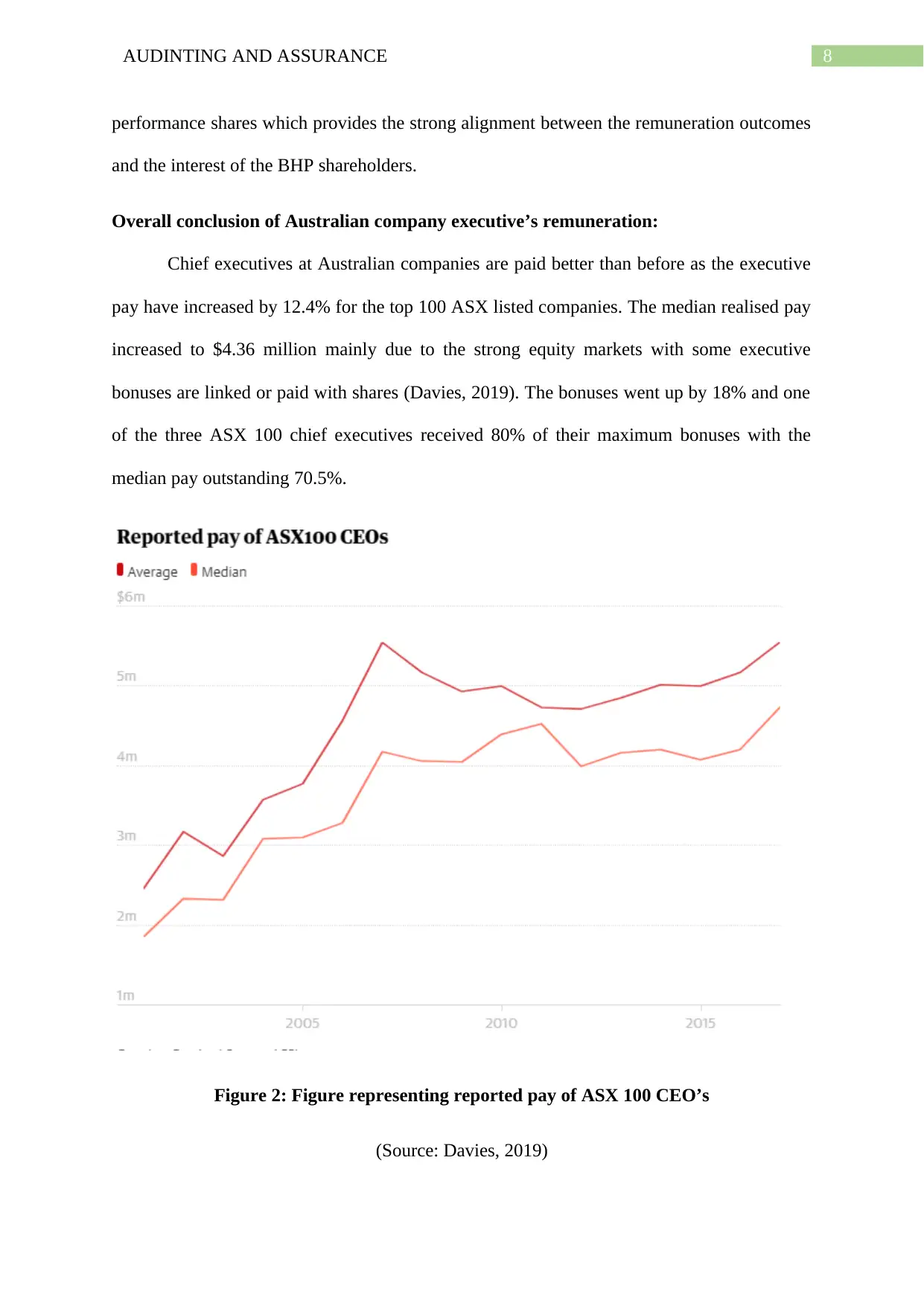
8AUDINTING AND ASSURANCE
performance shares which provides the strong alignment between the remuneration outcomes
and the interest of the BHP shareholders.
Overall conclusion of Australian company executive’s remuneration:
Chief executives at Australian companies are paid better than before as the executive
pay have increased by 12.4% for the top 100 ASX listed companies. The median realised pay
increased to $4.36 million mainly due to the strong equity markets with some executive
bonuses are linked or paid with shares (Davies, 2019). The bonuses went up by 18% and one
of the three ASX 100 chief executives received 80% of their maximum bonuses with the
median pay outstanding 70.5%.
Figure 2: Figure representing reported pay of ASX 100 CEO’s
(Source: Davies, 2019)
performance shares which provides the strong alignment between the remuneration outcomes
and the interest of the BHP shareholders.
Overall conclusion of Australian company executive’s remuneration:
Chief executives at Australian companies are paid better than before as the executive
pay have increased by 12.4% for the top 100 ASX listed companies. The median realised pay
increased to $4.36 million mainly due to the strong equity markets with some executive
bonuses are linked or paid with shares (Davies, 2019). The bonuses went up by 18% and one
of the three ASX 100 chief executives received 80% of their maximum bonuses with the
median pay outstanding 70.5%.
Figure 2: Figure representing reported pay of ASX 100 CEO’s
(Source: Davies, 2019)
⊘ This is a preview!⊘
Do you want full access?
Subscribe today to unlock all pages.

Trusted by 1+ million students worldwide
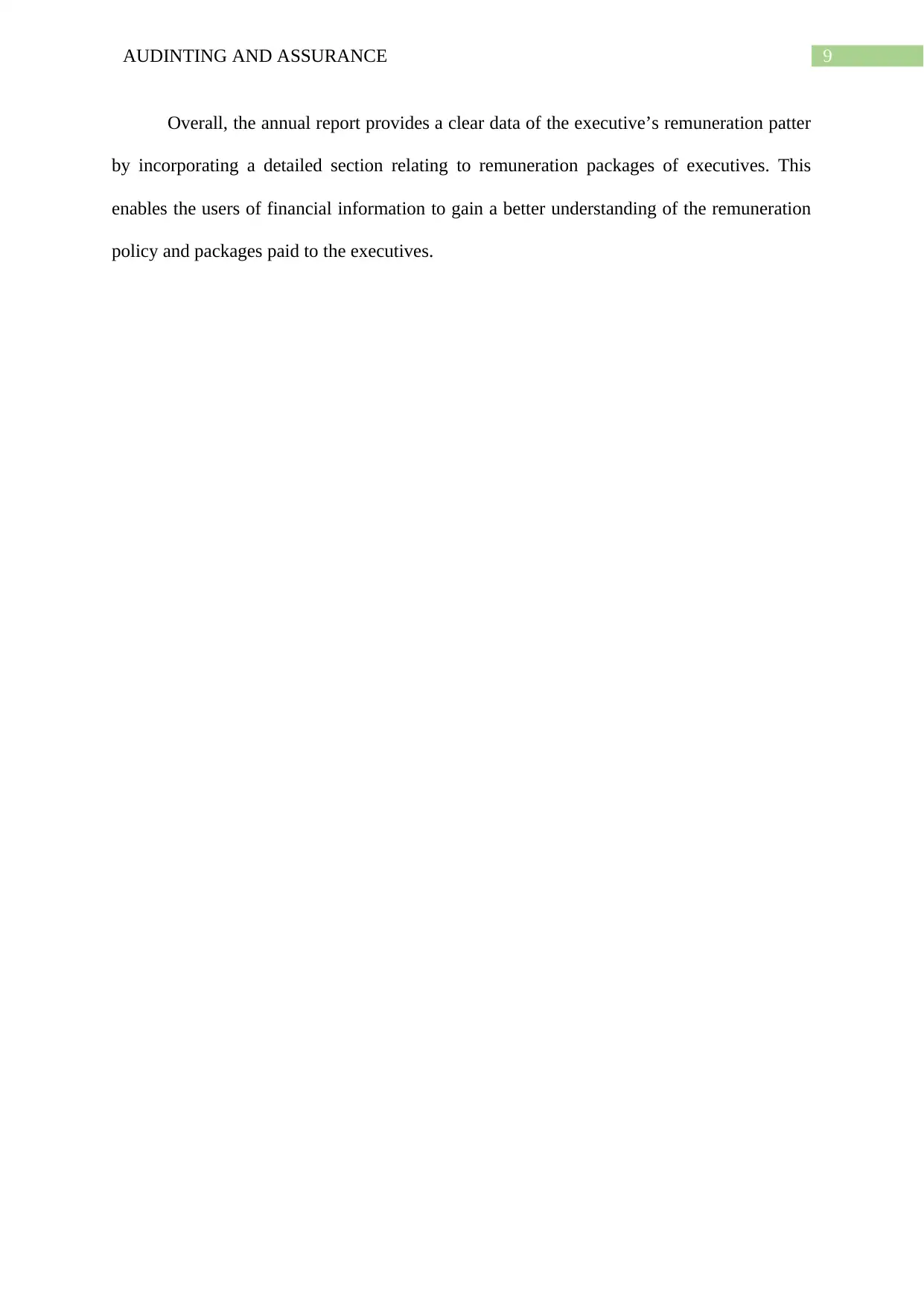
9AUDINTING AND ASSURANCE
Overall, the annual report provides a clear data of the executive’s remuneration patter
by incorporating a detailed section relating to remuneration packages of executives. This
enables the users of financial information to gain a better understanding of the remuneration
policy and packages paid to the executives.
Overall, the annual report provides a clear data of the executive’s remuneration patter
by incorporating a detailed section relating to remuneration packages of executives. This
enables the users of financial information to gain a better understanding of the remuneration
policy and packages paid to the executives.
Paraphrase This Document
Need a fresh take? Get an instant paraphrase of this document with our AI Paraphraser
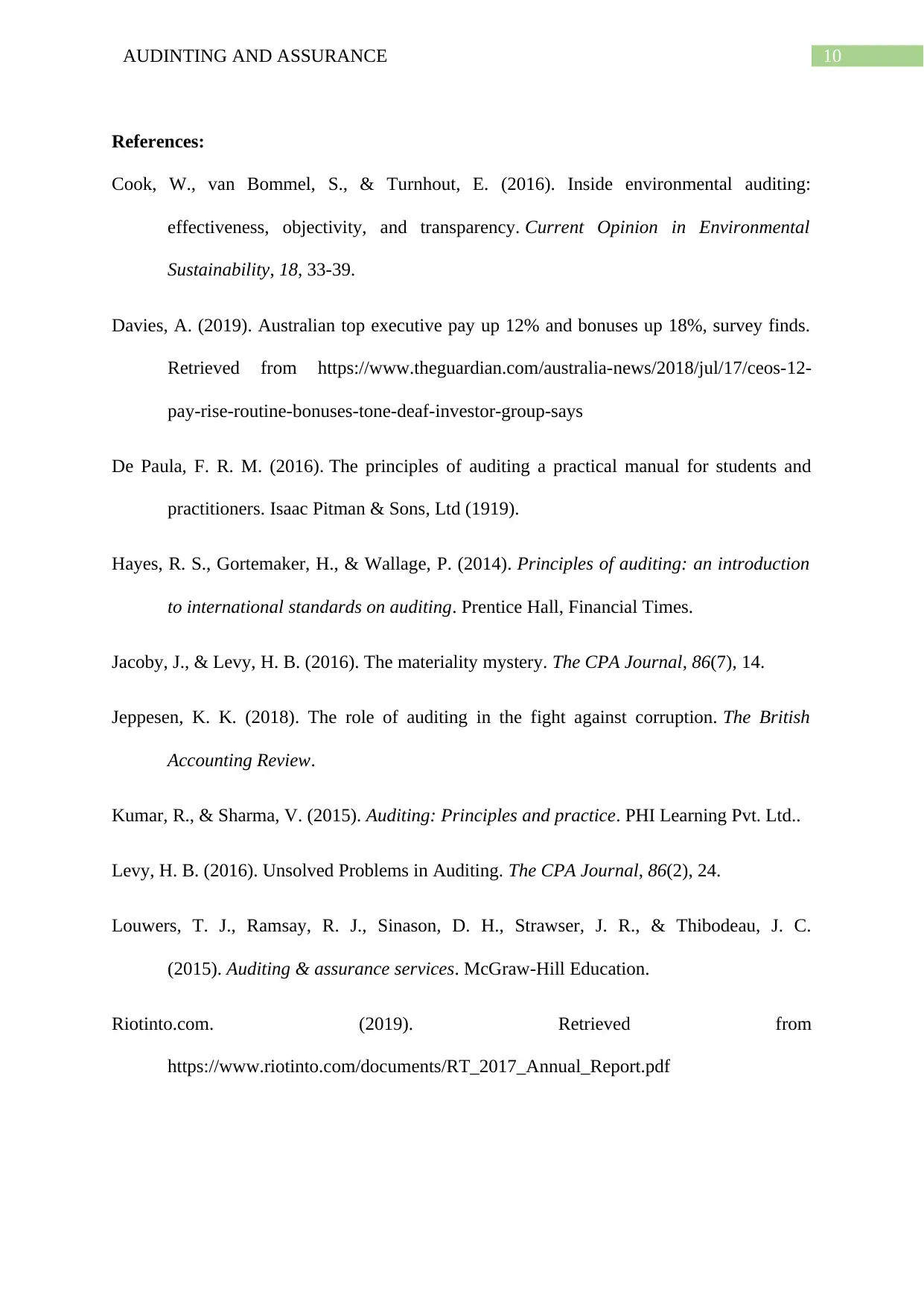
10AUDINTING AND ASSURANCE
References:
Cook, W., van Bommel, S., & Turnhout, E. (2016). Inside environmental auditing:
effectiveness, objectivity, and transparency. Current Opinion in Environmental
Sustainability, 18, 33-39.
Davies, A. (2019). Australian top executive pay up 12% and bonuses up 18%, survey finds.
Retrieved from https://www.theguardian.com/australia-news/2018/jul/17/ceos-12-
pay-rise-routine-bonuses-tone-deaf-investor-group-says
De Paula, F. R. M. (2016). The principles of auditing a practical manual for students and
practitioners. Isaac Pitman & Sons, Ltd (1919).
Hayes, R. S., Gortemaker, H., & Wallage, P. (2014). Principles of auditing: an introduction
to international standards on auditing. Prentice Hall, Financial Times.
Jacoby, J., & Levy, H. B. (2016). The materiality mystery. The CPA Journal, 86(7), 14.
Jeppesen, K. K. (2018). The role of auditing in the fight against corruption. The British
Accounting Review.
Kumar, R., & Sharma, V. (2015). Auditing: Principles and practice. PHI Learning Pvt. Ltd..
Levy, H. B. (2016). Unsolved Problems in Auditing. The CPA Journal, 86(2), 24.
Louwers, T. J., Ramsay, R. J., Sinason, D. H., Strawser, J. R., & Thibodeau, J. C.
(2015). Auditing & assurance services. McGraw-Hill Education.
Riotinto.com. (2019). Retrieved from
https://www.riotinto.com/documents/RT_2017_Annual_Report.pdf
References:
Cook, W., van Bommel, S., & Turnhout, E. (2016). Inside environmental auditing:
effectiveness, objectivity, and transparency. Current Opinion in Environmental
Sustainability, 18, 33-39.
Davies, A. (2019). Australian top executive pay up 12% and bonuses up 18%, survey finds.
Retrieved from https://www.theguardian.com/australia-news/2018/jul/17/ceos-12-
pay-rise-routine-bonuses-tone-deaf-investor-group-says
De Paula, F. R. M. (2016). The principles of auditing a practical manual for students and
practitioners. Isaac Pitman & Sons, Ltd (1919).
Hayes, R. S., Gortemaker, H., & Wallage, P. (2014). Principles of auditing: an introduction
to international standards on auditing. Prentice Hall, Financial Times.
Jacoby, J., & Levy, H. B. (2016). The materiality mystery. The CPA Journal, 86(7), 14.
Jeppesen, K. K. (2018). The role of auditing in the fight against corruption. The British
Accounting Review.
Kumar, R., & Sharma, V. (2015). Auditing: Principles and practice. PHI Learning Pvt. Ltd..
Levy, H. B. (2016). Unsolved Problems in Auditing. The CPA Journal, 86(2), 24.
Louwers, T. J., Ramsay, R. J., Sinason, D. H., Strawser, J. R., & Thibodeau, J. C.
(2015). Auditing & assurance services. McGraw-Hill Education.
Riotinto.com. (2019). Retrieved from
https://www.riotinto.com/documents/RT_2017_Annual_Report.pdf
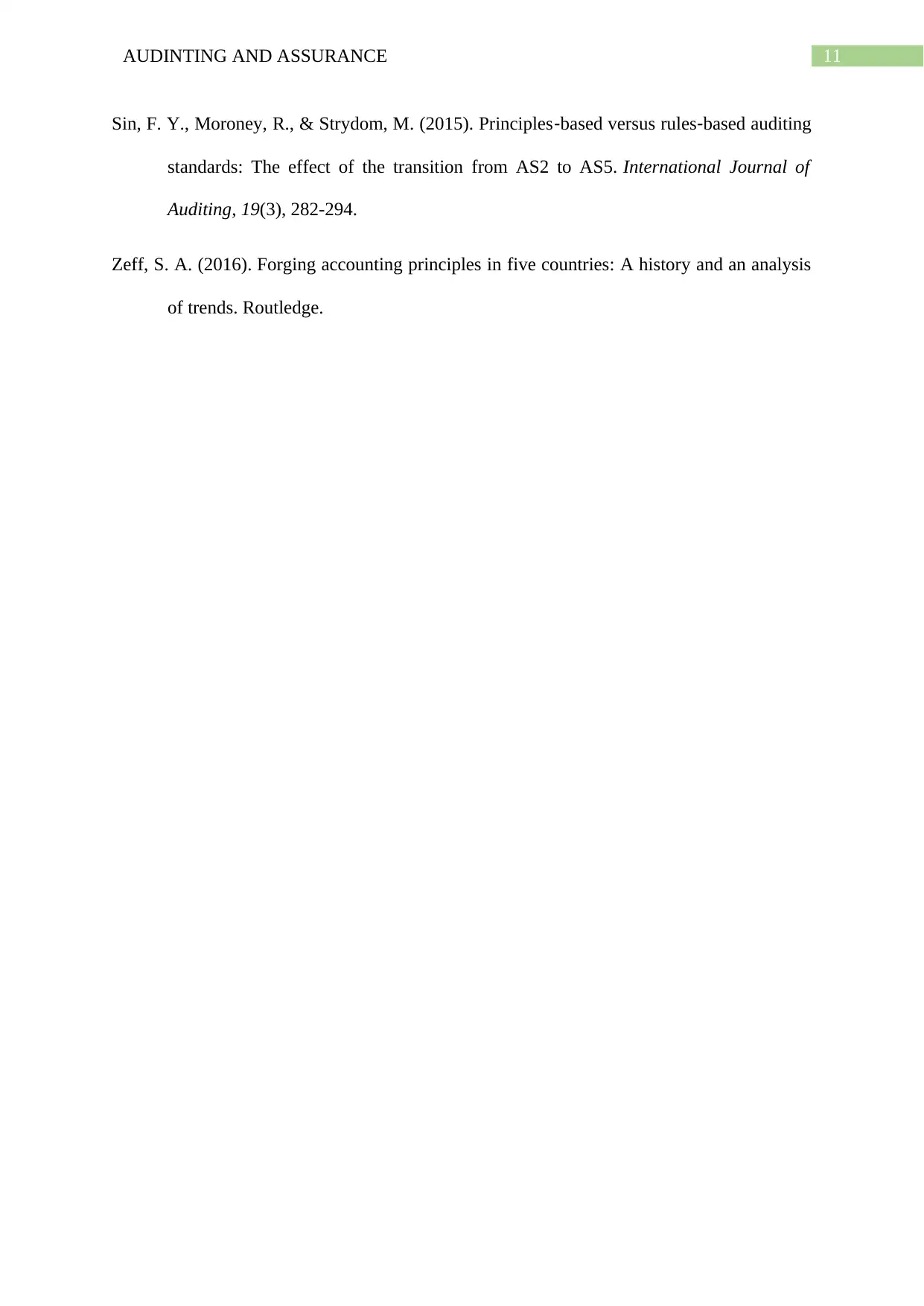
11AUDINTING AND ASSURANCE
Sin, F. Y., Moroney, R., & Strydom, M. (2015). Principles‐based versus rules‐based auditing
standards: The effect of the transition from AS2 to AS5. International Journal of
Auditing, 19(3), 282-294.
Zeff, S. A. (2016). Forging accounting principles in five countries: A history and an analysis
of trends. Routledge.
Sin, F. Y., Moroney, R., & Strydom, M. (2015). Principles‐based versus rules‐based auditing
standards: The effect of the transition from AS2 to AS5. International Journal of
Auditing, 19(3), 282-294.
Zeff, S. A. (2016). Forging accounting principles in five countries: A history and an analysis
of trends. Routledge.
⊘ This is a preview!⊘
Do you want full access?
Subscribe today to unlock all pages.

Trusted by 1+ million students worldwide
1 out of 12
Related Documents
Your All-in-One AI-Powered Toolkit for Academic Success.
+13062052269
info@desklib.com
Available 24*7 on WhatsApp / Email
![[object Object]](/_next/static/media/star-bottom.7253800d.svg)
Unlock your academic potential
Copyright © 2020–2025 A2Z Services. All Rights Reserved. Developed and managed by ZUCOL.





